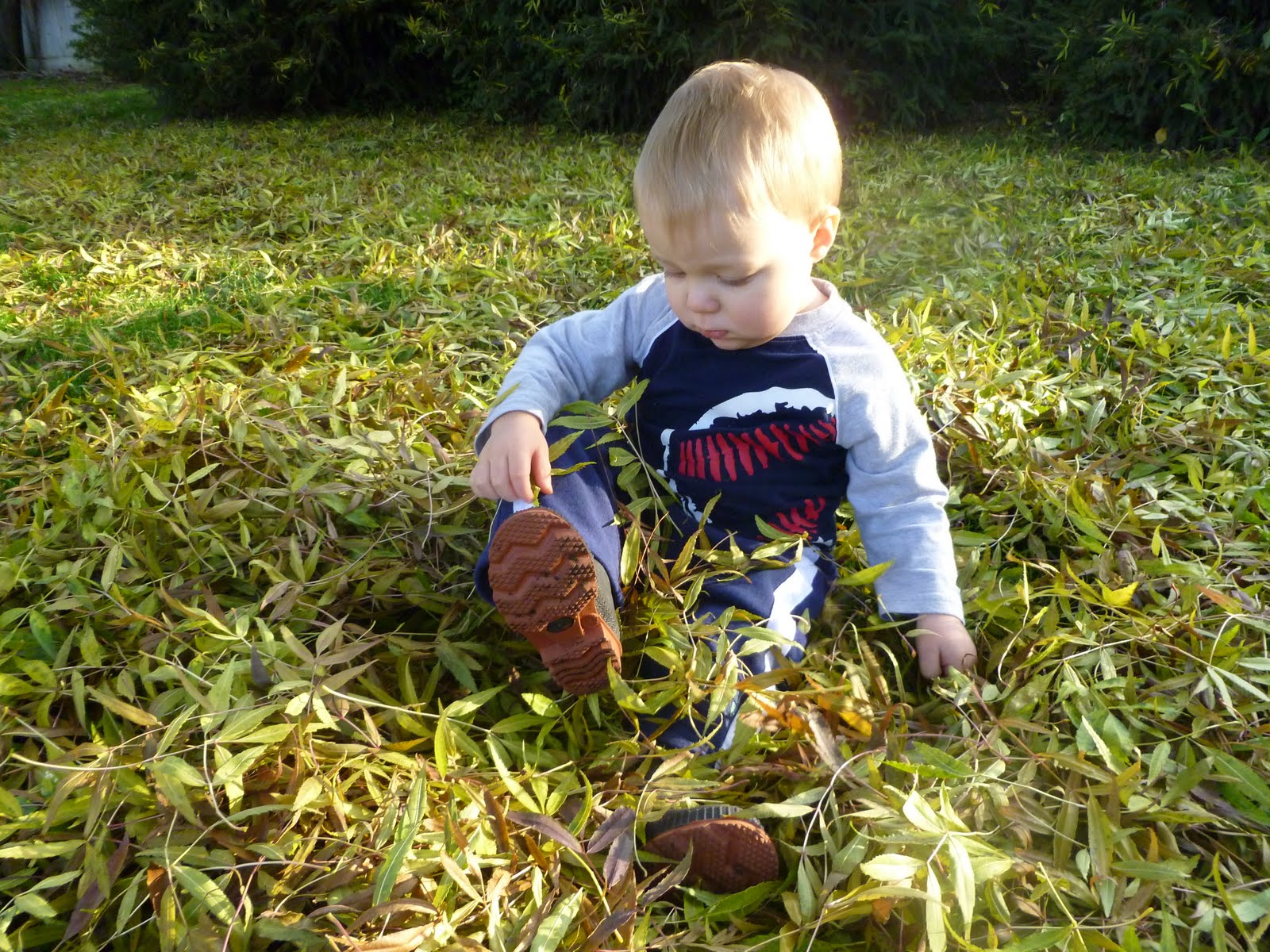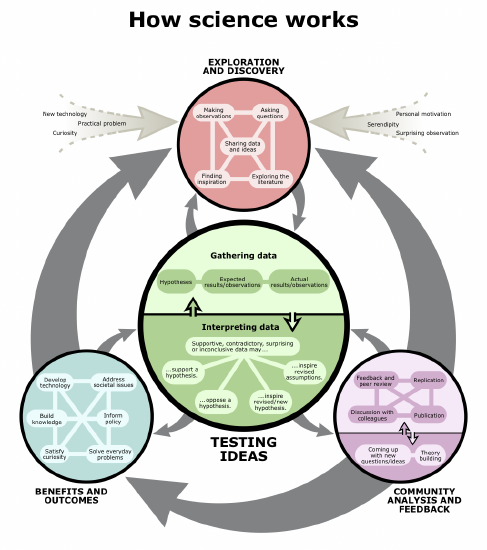1.1.4: Anthropologists as Scientists
- Last updated
- Save as PDF
- Page ID
- 136369
Biological anthropologists use the scientific method as a way of learning about the world around them. Many people think of science as taking place in a sterile laboratory, and sometimes it does, but in biological anthropology it also occurs many other places, such as at a research station in Ethiopia, a field site in Tanzania, and a town in El Salvador. To understand how information in this field is established, it is important to recognize what science is (and is not) as well as understand how the scientific method actually works.
Recognizing Science
Science combines our natural curiosity with our ability to experiment so we can understand the world around us and address needs in our communities. Thanks to science, meteorologists can predict the weather, it takes only a relatively small number of farmers to grow enough food to feed our large population, our medicine continues to improve, and over 90% of Americans have a cell phone.
Anyone can participate in science—not just academics. In fact, children are often some of the best scientists. An early, well-known psychologist, Jean Piaget (1896–1980), argued that a child is a “little scientist,” internally motivated to experiment and explore their world. This can be seen when an infant repeatedly drops a toy to see if the parent will pick it up, or when a four-year-old sincerely asks “why” again and again. Maria Montessori (1870–1952), an Italian doctor and educator, was interested in how children learn. Through her research, she also recognized that children have natural scientific tendencies. Children have a desire to explore their environment, ask questions, use their imaginations, and learn by doing. In 1907, Montessori opened a school to foster children’s natural desire to learn this way. This developed a child-centered teaching method that has spread around the world and is being used in over 22,000 schools today. In anthropology and other scientific fields, the process of learning is more formalized, but scientists still benefit from the curiosity that motivates children and still experience the thrill of discovery.
 Figure \(\PageIndex{1}\): Children are true scientists as they explore and test the world around them through sight and touch.
Figure \(\PageIndex{1}\): Children are true scientists as they explore and test the world around them through sight and touch.Science represents both a body of knowledge and the process for learning that knowledge (the scientific method). Scientific claims can, at times, be difficult to distinguish from other information. Science also incorporates a broad range of methods to collect data, adding to the difficulty of knowing what science really is. This section of the chapter will address four key characteristics that help define and recognize science: (1) science studies the physical and natural world and how it works, (2) scientific explanations must be testable and refutable, (3) science relies on empirical evidence, and (4) science involves the scientific community.
Science Studies the Physical and Natural World and How It Works

Our physical and natural universe ranges from very small (e.g., electrons) to the very large (e.g., Earth itself and galaxies beyond it). Scientists often design their research to address how and why natural forces influence our physical and natural word. In biological anthropology, we focus our questions on humans as well as primate species, both living and extinct. We ask questions like: What influences a primate’s diet? Why do humans walk bipedally? And did Neanderthals and modern humans interbreed?
There are very few questions that are considered off-limits in science. That being said, the scope of scientific investigation is generally focused on natural phenomena and natural processes and excludes the supernatural. People often regard the supernatural, whether it be a ghost, luck, or god, as working outside the laws of the universe, which makes it difficult to study with a scientific approach. Science neither supports nor contradicts the existence of supernatural powers—it simply does not include the supernatural in its explanations.
Scientific Explanations Must Be Testable and Refutable
The goal of scientists is to identify a research question and then identify the best answer(s) to that question. For example, an excavation of a prehistoric cemetery may reveal that many of the people buried there had unhealed fractures when they died, and the lead anthropologist may ask, “Why did this population experience more broken bones than their neighbors?” There might be multiple explanations to address this question, such as a lack of calcium in their diets, participation in dangerous work, or violent conflict with neighbors; these explanations are considered hypotheses. In the past, you might have learned that a hypothesis is an “educated guess,” but in science, hypotheses are much more than that. A scientific hypothesis reflects a scientist’s knowledge-based experiences and background research. A hypothesis is better defined as an explanation of observed facts; hypotheses explain how and why observed phenomena are the way they are.
Scientific hypotheses should generate expectations that are testable. For example, if the best explanation regarding our prehistoric population was that they were experiencing violent conflict with their neighbors, we should expect to find clues, like weapons or protective walls around their homes, in the anthropological record to support this. Alternatively, if this population did not experience violent conflict with their neighbors, we may eventually be able to gather enough evidence to rule out (refute) this explanation. An important part of science is rigorous testing. Science does not prove any hypothesis. However, a strong hypothesis is one that has strong supporting evidence and has not yet been disproven.
Science Relies on Empirical Evidence
The word “empirical” refers to experience that is verified by observation (rather than evidence that derives primarily from logic or theory). In anthropology, much evidence about our world is collected by observation through fieldwork or in a laboratory. The most reliable studies are based on accurately and precisely recorded observations. Scientists value studies that explain exactly what methods were used, so their data collection and analysis processes are reproducible. This allows for other scientists to expand the study or provide new insights into the observations.
Science Involves the Scientific Community
Contrary to many Hollywood science fiction films, good science is not carried out in isolation in a secret basement laboratory but rather is done as part of a community. Scientists pay attention to what others have done before them, present new ideas to each other, and publish in scientific journals. Most scientific research is collaborative, bringing together researchers with different types of specialized knowledge to work on a shared project. Today, thanks to technology, scientific projects can bring together researchers from different backgrounds, experiences, locations, and perspectives. Most big anthropological questions—“Where did modern humans develop?” “What genetic changes make us uniquely human?” “How did cooperative behavior evolve?”—cannot be addressed with one simple study, but are tested with different lines of evidence and by different scientists over time.
Working within a scientific community supports one of the most valuable aspects of science: that science is self-correcting. Science that is openly communicated with others allows for a system with checks and balances: competing explanations can be proposed and questionable studies can be reevaluated. Ultimately, the belief is that through science the best explanations will stand the test of time.
How Science Works: The Scientific Method
Most students have learned the scientific method as a simple linear, or perhaps circular, process. Textbooks may phrase each step differently, but students usually recognize that the process begins with making observations about the natural world. Another important step is the selection or development of a scientific hypothesis. From the hypothesis a set of predictions can be made, which are then tested by experimentation or by making additional observations. Scientific predictions are often phrased as “if… then…” statements, such as “If hypothesis A is true, then this experiment will show outcome B.” The results of a scientific study should then either support or reject the hypothesis.
 Figure \(\PageIndex{3}\): Simple depiction of the scientific method.
Figure \(\PageIndex{3}\): Simple depiction of the scientific method.This relatively simple version of the scientific method is valuable as it highlights the key aspects that should be present in any scientific research experiment or scientific paper. However, this simplistic view of the scientific method does not accurately represent the dynamic and creative side of science, nor does it highlight the complex steps that are incorporated into a scientist’s routine.
 Figure \(\PageIndex{4}\): Complex flow of the scientific method.
Figure \(\PageIndex{4}\): Complex flow of the scientific method.Figure 1.24 provides an alternative representation of the scientific method that emphasizes the many paths to scientific discovery. While still incorporating the key components of making observations, testing ideas, and interpreting results, this chart shows that scientific ideas have many possible starting points and influences, and scientists often repeat steps and circle back around. Gathering evidence does not always rest on experiments in the laboratory. Evaluating data is not always clear-cut, and results are sometimes surprising or inconclusive. Many important discoveries were in fact made by mistake. For example, engineer Percy Spencer accidentally melted a chocolate bar in his pocket with a magnetron, which became the first microwave, and Spencer Silver invented the adhesive for 3M Post-it ® notes while trying to develop a strong glue. The real scientific process is more similar to the philosophy of the animated television character Ms. Frizzle from The Magic School Bus, “Take chances, make mistakes, get messy.”
Two key components lacking in the simple version of the scientific method are exploration and discovery. There are many reasons that a scientist might choose a particular research question: they may be motivated by personal experience, struck by something they read about, or inspired by a student’s question in class. Often scientific research reveals more questions than answers, so experienced researchers rarely lack problems to solve. But identifying a research question is just part of the process; most scientists spend more time exploring the literature, sharing ideas, asking questions, and planning their research project than conducting the test itself.
Science itself is a social enterprise that is influenced by cultural issues and values, as well as funding priorities. For example, corporations are the biggest funders of scientific research, followed next by government agencies like the National Science Foundation (which often fund research done by academics at colleges and universities). Those organizations have great influence on what is considered valuable research at any given time. For example, there are many diseases that the World Health Organization (WHO) has classified as “neglected tropical diseases,” including dengue, leprosy, rabies, and hookworm, that affect an estimated 1 billion people, mostly in impoverished areas. These debilitating diseases can be as deadly as diseases that receive more attention, like AIDS and tuberculosis, but these tropical diseases receive comparatively little funding when it comes to research, drug development, and health care development (Farmer et al. 2013).
Also very important to the scientific process are interactions within the scientific community. Scientific collaboration can take place through informal discussion over a cup of coffee, but also includes more formal interactions, such as presenting at conferences and engaging in scholarly peer review. Scholarly peer review is the process where an author’s work must pass the scrutiny of other experts in the field before being published in a journal or book. This helps keep scientists accountable for ethically responsible research projects and papers. Additionally, presenting data at conferences and in articles and books allows researchers to potentially receive critical feedback from academic peers and others to test these ideas and further the field of science toward identifying the best explanations.
Hypotheses, Theories, and Laws
Scientific investigation occurs at many levels, from investigating individual cases (for example, “What is causing this child’s mysterious illness?”) to understanding processes that affect most of us (“What is the ideal amount of sleep for an adult?”). All of these questions are important and will generate different types of testable scientific explanations. So far, we have used the term “hypothesis” to describe these scientific explanations for why observed phenomena are the way they are. Hypotheses are typically explanations that address a narrow set of phenomena, such as (in anthropology), a particular population or primate species.
In science, a theory is an explanation of observations that addresses a wide range of phenomena. Like hypotheses, theories also explain how or why something occurs, rely on empirical evidence, and are testable and able to be refuted. Because the term theory is often used casually outside of science, you may hear people try to dismiss a scientific claim as “just a theory.” In science there are often multiple competing theories, but over time some are eliminated, leaving the theory or theories that best explain the most evidence. Scientific theories that have stood the test of time are thus supported by many lines of evidence and are usually reliable. Some well-tested theories accepted by most scientists include the theory of general relativity, which explains the law of gravitation and its relation to other forces, and evolutionary theory, which describes how heritable traits can change in a population over time.
While scientific hypotheses and theories share many characteristics, laws are quite different. A law is a prediction about what will happen given certain conditions, not an explanation for how or why it happens. A law is not a “mature” version of a theory. For example, Newton’s universal law of gravity allows us to predict the gravitational force (F) between any two objects using the equation F = G(m1m2)/r2, but it does not explain why gravity works. Laws are often mathematical, and some well-known laws include Newton’s three laws of motion and laws of genetic inheritance. Laws are important, and their discovery often promotes the development of theories.
 Figure \(\PageIndex{5}\): Archimedes is portrayed here having just discovered his Principle of Buoyancy. The vignette is by Count Giammaria Mazzuchelli (1707–1765).
Figure \(\PageIndex{5}\): Archimedes is portrayed here having just discovered his Principle of Buoyancy. The vignette is by Count Giammaria Mazzuchelli (1707–1765).To demonstrate how important laws can be—and show how unusual things can inspire scientific discoveries—we can use the story of the ancient Greek mathematician and inventor Archimedes. Archimedes’ buoyancy principle is a law that is useful for many things, including density calculations and designing ships. Purportedly, he made this discovery when he noticed the water level rise in the bathtub when he climbed in it. Realizing its importance, he is said to have shouted “Eureka” and proceeded to run naked through the city of Syracuse. While this is a fun story (that may or may not be true), it does remain that scientific laws, alongside scientific hypotheses and theories, do have a very important role in the scientific process and in generating scientific explanations about our natural world.

